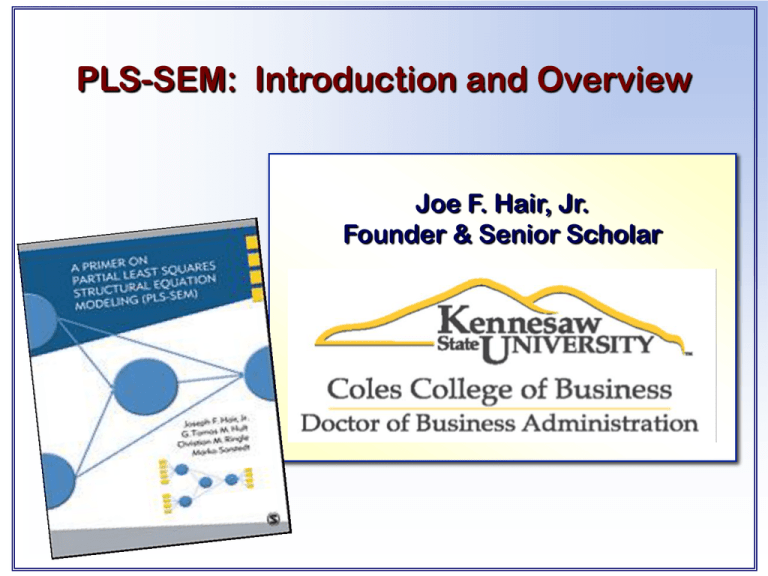
PLS-SEM: Introduction and Overview
Joe F. Hair, Jr.
Founder & Senior Scholar
The greatest interest in any factor solution centers on the correlations between the original
variables and the factors. The matrix of such test-factor correlations is called the factor structure,
and it is the primary interpretative device in principal components analysis. In the factor
structure the element rjk gives the correlation of the jth test with the kth factor. Assuming that the
content of the observation variables is well known, the correlations in the kth column of the
structure help in interpreting, and perhaps naming, the kth factor. Also, the coefficients in the jth
row give the best view of the factor composition of the jth test.
The derivation
of the factor
structure
S is as follows
:
N
S 1
N
(z i m
1
N
z ifi
1
N
z i (L
1
N
( z i z i ) VL
z
)( f i m
f
)
i 1
RVL
1 / 2
V z i )
1 / 2
1 / 2
and since
RV VL
S VLL
1 / 2
VL
1/ 2
Another set of coefficients of interest in factor analysis is the weights that compound predicted
observations z from factor scores f. These regression coefficients for the multiple regression of
each element of the observation vector z on the factor f are called factor loadings and the matrix A
that contains them as its rows is . . . . .
Source: Cooley, William W., and Paul R. Lohnes, Multivariate Data Analysis, John Wiley & Sons,
Inc., New York, 1971, page 106.
SEM Model:
Predicting the Birth Weight
of Guinea Pigs
X & Y = different outcomes
B, C & D = common causes
A & E = independent causes
Sewall Wright, Correlation and Causation, Journal
of Agricultural Research, Vol. XX, No. 7, 1921.
Structural Equations Modeling
What comes to mind?
Structural Equations Modeling
Wireless Phone Service
Advertising
Budget
Brand
Attitudes
Purchase
Likelihood
Experience
Information
Search
Risk
Structural Equations Modeling (SEM)
Two Steps:
1. Confirm measurement model (CFA) = CFA assesses
reliability and validity of the model’s constructs.
CB-SEM – must achieve fit to move to 2nd step.
PLS-SEM – confirm measurement before examining
structural model (2nd step).
2. Evaluate structural model (SEM) = SEM determines
whether hypothesized relationships exist between
the constructs.
In developing models to test using CFA/SEM,
researchers draw upon theory, prior experience,
expert judgment, and research objectives to identify
and develop hypotheses about relationships between
multiple independent and dependent variables.
CB-SEM (Covariance-based SEM)
– statistical objective = to reproduce
the theoretical covariance matrix,
without focusing on explained variance.
PLS-SEM (Partial Least Squares SEM)
– statistical objective = to maximize the
explained variance of the endogenous
latent constructs (dependent variables).
CB-SEM – statistical objective (goodness of fit)
= minimize the differences between the
observed covariance matrix and the estimated
covariance matrix.
Research objective: testing and confirmation where
prior theory is strong.
• Assumes normality of data distribution,
homoscedasticity, large sample size, etc.
• A “full information approach” which means small
changes in model specification can result in
substantial changes in model fit.
PLS-SEM – statistical objective = maximize the
explained (predicted) variance of the
dependent variables.
Research objective: theory development and prediction.
• Normality of data distribution not assumed.
• Good solutions with smaller sample sizes.
• Measurement models:
Can be used with fewer indicator variables (1 or 2)
per construct.
OK to have ordinal scaled questions.
Can include a larger number of indicator variables
(CB-SEM = solution unlikely with 50+ items).
• Preferred alternative with formative constructs.
PLS Path Model
Steps 1 & 2 are combined,
but still look at measurement
theory first before moving to
structural model assessment.
Which SEM Approach Should Be Used?
Rules of Thumb: PLS-SEM or CB-SEM
Use CB-SEM when:
•The goal is theory testing, theory confirmation, or
the comparison of alternative theories.
•Structural model has non-recursive relationships.
•Research requires a global goodness of fit criterion.
Rules of Thumb: PLS-SEM or CB-SEM?
Use PLS-SEM when:
•The goal is predicting key target constructs.
•Formative constructs are included in the structural model.
Note that formative measures can also be used with CB-SEM,
but doing so requires construct specification modifications
(e.g., the construct must include both formative and reflective
indicators to meet identification requirements = MIMIC
measurement model).
•The structural model is complex (many constructs and many
indicators).
•The sample size is small and/or the data is not-normally
distributed.
•The plan is to use latent variable scores in subsequent
analyses.
Should You Use SEM In Your Research?
Journal reviewers rate SEM papers more favorably
on key manuscript attributes . . .
Mean Score
Attributes
Topic Relevance
Research Methods
Data Analysis
Conceptualization
Writing Quality
Contribution
SEM
4.2
3.5
3.5
3.1
3.9
3.1
No SEM
3.8
2.7
2.8
2.5
3.0
2.8
p-value
.182
.006
.025
.018
.006
.328
Note: scores based on 5-point scale, with 5 = more favorable
Source: Babin, Hair & Boles, Publishing Research in Marketing Journals
Using Structural Equation Modeling, Journal of Marketing Theory and
Practice, Vol. 16, No. 4, 2008, pp. 281-288.
The use of PLS-SEM is increasing in different fields
Marketing (Hair et al. 2012a)
Cumulative number of articles
200
180
160
140
120
MISQ (Ringle et al. 2012)
100
80
60
Strategic Mgmt.
40
(Ringle et al. 2012b)
20
Mgmt. Accounting
0
(Nitzl 2012)
1980
1990
2000
2010
Year
Hair, J. F., M. Sarstedt, C. M. Ringle, and J. A. Mena (2012a). An Assessment of the Use of Partial Least Squares Structural Equation
Modeling in Marketing Research, Journal of the Academy of Marketing Science, 40 (3), 414-433.
Hair, J. F., M. Sarstedt, T. Pieper, and C. M. Ringle (2012b). The Use of Partial Least Squares Structural Equation Modeling in Strategic
Management Research: A Review of Past Practices and Recommendations for Future Applications, Long Range Planning, 45(5/6), 320-340.
Nitzl, C. (2012). The Use of Partial Least Squares Path Modeling in Management Accounting, White Paper.
Ringle, C. M., M. Sarstedt, and D. Straub (2012). A Critical Look at the Application of PLS-SEM in MIS Quarterly, MIS Quarterly, 36(1), iii-xiv.
All rights reserved ©. Cannot be reproduced or
distributed without express written permission from
15
.
.
All rights reserved ©. Cannot be reproduced or distributed without express written permission from
Prentice-Hall, McGraw-Hill, Sage, SmartPLS, and session presenters.
.
A PLS path model consists of two elements:
First, there is a structural model (also referred to as the
inner model in the context of PLS-SEM) that represents the
constructs (circles or ovals). The structural model also
displays the relationships (paths) between the constructs.
Second, there are the measurement models (also referred to
as the outer models in PLS-SEM) of the constructs that
display the relationships between the constructs and the
indicator variables (rectangles).
There are two types of constructs in a SEM: the exogenous
latent variables (i.e., those constructs that explain other
constructs in the model) and the endogenous latent
variables (i.e., those constructs that are being explained in
the model).
All rights reserved ©. Cannot be reproduced or distributed without express written permission from
Prentice-Hall, McGraw-Hill, Sage, SmartPLS, and session presenters.
Path models = diagrams used to visually display the hypotheses
and variable relationships that are examined when SEM is applied.
Constructs = variables that are not directly measured) are
represented in path models as circles or ovals (Y1 to Y4).
Indicators = also referred to as items or manifest variables, are
the directly measured proxy variables that contain the raw data.
They are represented in path models as rectangles (x1 to x10).
Paths = relationships between constructs, and between constructs
and their assigned indicators, shown as arrows. In PLS-SEM, the
arrows are always single-headed, thus representing directional
relationships. Single-headed arrows are considered a predictive
relationship, and with strong theoretical support, can be
interpreted as causal relationships.
All rights reserved ©. Cannot be reproduced or distributed without express written permission from
Prentice-Hall, McGraw-Hill, Sage, SmartPLS, and session presenters.
Error terms = The error terms (e.g., e7 or e8; Exhibit 1.4) are
connected to the (endogenous) constructs and (reflectively)
measured variables by single-headed arrows. Error terms represent
the unexplained variance when path models are estimated.
In Exhibit 1.4, error terms e7 to e10 are on those indicators whose
relationships go from the construct to the indicator (i.e., reflectively
measured indicators). In contrast, the formatively measured
indicators x1 to x6, where the relationship goes from the indicator to
the construct, do not have error.terms.
The structural model also contains error terms. In Exhibit 1.4, z3 and
z4 are associated with the endogenous latent variables Y3 and Y4
(note that error terms on constructs and measured variables are
labeled differently). In contrast, the exogenous latent variables that
only explain other latent variables in the structural model do not have
an error term.
All rights reserved ©. Cannot be reproduced or distributed without express written permission from
Prentice-Hall, McGraw-Hill, Sage, SmartPLS, and session presenters.
Reflective (Scale) Versus Formative (Index)
Operationalization of Constructs
A central research question in social science research, particularly marketing,
management & MIS, focuses on the operationalization of complex constructs:
Are indicators causing or being caused by
the latent variable/construct measured by them?
Indicator 1
Indicator 2
Indicator 3
Construct
Changes in the latent
variable directly cause
changes in the assigned
indicators
Indicator 1
?
Indicator 2
Indicator 3
Construct
Changes in one or more of
the indicators causes
changes in the latent variable
Example: Reflective vs. Formative World View
Can’t walk a straight
line
Drunkenness
Smells of alcohol
Slurred speech
Example: Reflective vs. Formative World View
Consumption of beer
Drunkenness
Consumption of wine
Consumption of hard
liquor
Basic Difference Between Reflective and
Formative Measurement Approaches
“Whereas reflective indicators are essentially interchangeable (and
therefore the removal of an item does not change the essential
nature of the underlying construct), with formative indicators
‘omitting an indicator is omitting a part of the construct’.”
(DIAMANTOPOULOS/WINKLHOFER, 2001, p. 271)
The formative measurement approach
generally minimizes the overlap
between complementary indicators
Construct
domain
Construct
domain
The reflective measurement approach
focuses on maximizing the overlap
between interchangeable indicators
Exercise: Satisfaction in Hotels as Formative
and Reflective Operationalized Constructs
The
rooms‘ furnishings are
good
The hotel’s recreation
offerings are good
Taking everything into
account, I am satisfied
with this hotel
The hotel‘s personnel
are friendly
I appreciate this hotel
Satisfaction
with Hotels
The hotel is low-priced
I am looking forward to
staying overnight in
this hotel
The rooms are quiet
I am comfortable with
this hotel
The rooms are clean
The hotel’s service is
good
The hotel’s cuisine is
good
Formative Constructs – Two Types
1. Composite (formative) constructs – indicators completely
determine the “latent” construct. They share similarities because
they define a composite variable but may or may not have
conceptual unity. In assessing validity, indicators are not
interchangeable and should not be eliminated, because removing
an indicator will likely change the nature of the latent construct.
2. Causal constructs – indicators have conceptual unity in that
all variables should correspond to the definition of the concept. In
assessing validity some of the indicators may be interchangeable,
and also can be eliminated.
Bollen, K.A. (2011), Evaluating Effect, Composite, and Causal Indicators in
Structural Equations Models, MIS Quarterly, Vol. 35, No. 2, pp. 359-372.
Sample Size
The overall complexity of a structural model has little influence on the
sample size requirements for PLS-SEM. The reason is the algorithm does
not compute all relationships in the structural model at the same time.
Instead, it uses OLS regressions to estimate the model’s partial
regression relationships.
The 10 times rule indicates the sample size should be equal to the
larger of:
(1) 10 times the largest number of formative indicators used to
measure a single construct, or
(2) 10 times the largest number of structural paths directed at a
particular latent construct in the structural model.
This rule of thumb is equivalent to saying that the minimum sample
size should be 10 times the maximum number of arrowheads pointing at a
latent variable anywhere in the path model. While the 10 times rule offers
a rough guideline for minimum sample size requirements, PLS-SEM – like
any statistical technique – requires researchers to consider the sample
size against the background of the model and data characteristics.
Specifically, the required sample size should be determined using power
analyses based on the part of the model with the largest number of
predictors.
.
Statistical power assumed = 80%
Indicators for SEM Model Constructs
Competence (COMP)
comp_1
[company] is a top competitor in its market.
comp_2
As far as I know, [company] is recognized world-wide.
comp_3
I believe that [company] performs at a premium level.
Likeability (LIKE)
like_1
[company] is a company that I can better identify with than other companies.
like_2
[company] is a company that I would regret more not having if it no longer
existed than I would other companies.
I regard [company] as a likeable company.
like_3
Customer Loyalty (CUSL)
cusl_1
I would recommend [company] to friends and relatives.
cusl_2
If I had to choose again, I would chose [company] as my mobile phone services
provider.
I will remain a customer of [company] in the future.
cusl_3
Satisfaction (CUSA)
cusa
If you consider your experiences with [company] how satisfied are you with
[company]?
Extended Reputation Model Constructs


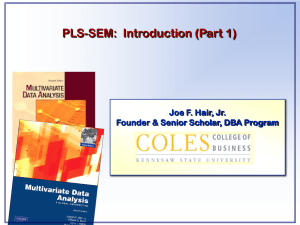
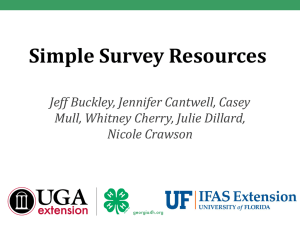

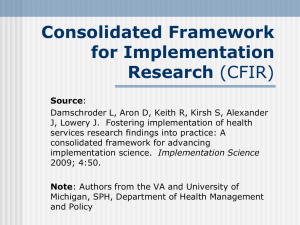



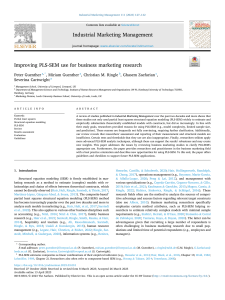
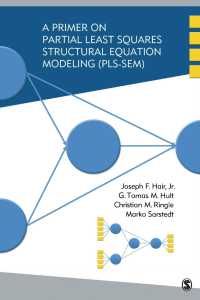
![A Primer on Partial Least Squares Structural Equation Modeling (PLS-SEM) [2nd ed.] by Joseph F. Hair, G. Tomas M. Hult, Christian M. Ringle, Marko Sarstedt (z-lib.org)](http://s2.studylib.net/store/data/027610740_1-96d323224889f6374cf63b82c72d14b7-300x300.png)